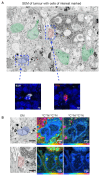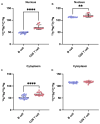A multimodal imaging pipeline to decipher cell-specific metabolic functions and tissue microenvironment dynamics
- PMID: 39880930
- PMCID: PMC7617660
- DOI: 10.1038/s41596-024-01118-4
A multimodal imaging pipeline to decipher cell-specific metabolic functions and tissue microenvironment dynamics
Abstract
Tissue microenvironments are extremely complex and heterogeneous. It is challenging to study metabolic interaction between the different cell types in a tissue with the techniques that are currently available. Here we describe a multimodal imaging pipeline that allows cell type identification and nanoscale tracing of stable isotope-labeled compounds. This pipeline extends upon the principles of correlative light, electron and ion microscopy, by combining confocal microscopy reporter or probe-based fluorescence, electron microscopy, stable isotope labeling and nanoscale secondary ion mass spectrometry. We apply this method to murine models of hepatocellular and mammary gland carcinomas to study uptake of glucose derived carbon (13C) and glutamine derived nitrogen (15N) by tumor-associated immune cells. In vivo labeling with fluorescent-tagged antibodies (B220, CD3, CD8a, CD68) in tandem with confocal microscopy allows for the identification of specific cell types (B cells, T cells and macrophages) in the tumor microenvironment. Subsequent image correlation with electron microscopy offers the contrast and resolution to image membranes and organelles. Nanoscale secondary ion mass spectrometry tracks the enrichment of stable isotopes within these intracellular compartments. The whole protocol described here would take ~6 weeks to perform from start to finish. Our pipeline caters to a broad spectrum of applications as it can easily be adapted to trace the uptake and utilization of any stable isotope-labeled nutrient, drug or a probe by defined cellular populations in any tissue in situ.
© 2025. Springer Nature Limited.
Conflict of interest statement
Competing interests: The authors declare no competing interests.
Figures






Similar articles
-
Comparing Raman and NanoSIMS for heavy water labeling of single cells.Microbiol Spectr. 2025 Jul;13(7):e0165924. doi: 10.1128/spectrum.01659-24. Epub 2025 May 30. Microbiol Spectr. 2025. PMID: 40445204 Free PMC article.
-
Variation within and between digital pathology and light microscopy for the diagnosis of histopathology slides: blinded crossover comparison study.Health Technol Assess. 2025 Jul;29(30):1-75. doi: 10.3310/SPLK4325. Health Technol Assess. 2025. PMID: 40654002 Free PMC article.
-
Leveraging a foundation model zoo for cell similarity search in oncological microscopy across devices.Front Oncol. 2025 Jun 18;15:1480384. doi: 10.3389/fonc.2025.1480384. eCollection 2025. Front Oncol. 2025. PMID: 40606969 Free PMC article.
-
The effect of sample site and collection procedure on identification of SARS-CoV-2 infection.Cochrane Database Syst Rev. 2024 Dec 16;12(12):CD014780. doi: 10.1002/14651858.CD014780. Cochrane Database Syst Rev. 2024. PMID: 39679851 Free PMC article.
-
Management of urinary stones by experts in stone disease (ESD 2025).Arch Ital Urol Androl. 2025 Jun 30;97(2):14085. doi: 10.4081/aiua.2025.14085. Epub 2025 Jun 30. Arch Ital Urol Androl. 2025. PMID: 40583613 Review.
Cited by
-
Stretchable electrode enabled electrochemical mass spectrometry for in situ and complementary analysis of cellular mechanotransduction.Chem Sci. 2025 Jun 9;16(28):13004-13011. doi: 10.1039/d5sc02191j. eCollection 2025 Jul 16. Chem Sci. 2025. PMID: 40535721 Free PMC article.
-
Spatiotemporal Heterogeneity of Tumor Glucose Metabolism Reprogramming: From Single-Cell Mechanisms to Precision Interventions.Int J Mol Sci. 2025 Jul 18;26(14):6901. doi: 10.3390/ijms26146901. Int J Mol Sci. 2025. PMID: 40725147 Free PMC article. Review.
-
Advancements in Tumor-Targeted Nanoparticles: Design Strategies and Multifunctional Therapeutic Approaches.Nanomaterials (Basel). 2025 Aug 15;15(16):1262. doi: 10.3390/nano15161262. Nanomaterials (Basel). 2025. PMID: 40863842 Free PMC article. Review.
References
-
- de Boer P, Hoogenboom JP, Giepmans BNG. Correlated light and electron microscopy: ultrastructure lights up! Nat Methods. 2015;12:503–513. - PubMed
Publication types
MeSH terms
Grants and funding
LinkOut - more resources
Full Text Sources
Research Materials

